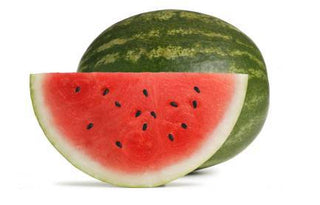(Citrullus Lanatus)
Looking for a way to quench your thirst on a hot summer day? Watermelon is the healthiest way to do so. Unlike most fruits, watermelon has a high water content - about 92 percent. So it’s no coincidence that this juicy fruit was named watermelon.
Part of the Cucurbitaceae family, watermelon is considered both a fruit and a plant. Its relatives include pumpkin, squash and cantaloupe. Although watermelon is considered a melon, it is not part of the melon family (Cucumis).
Watermelons come in many shapes and interior colors. While the common watermelon has red or green exterior and pink interior, some species of watermelon have an orange, yellow or even white interior. Some varieties of watermelon contain white, green or yellow seeds while other varieties are seedless. Watermelon can also vary in weight, ranging from five pounds to ninety pounds.
History
Watermelon was thought to have originated in Africa; however, according to hieroglyphics, watermelon was first cultivated in Egypt. It was such an important fruit that it was placed in the tombs of Egyptian kings to be taken into the afterlife. Egyptians were not the only people to see the importance of watermelon. In the Mediterranean, natives depended on watermelon to satisfy their thirst because water was so scarce in many regions.
After the discovery of the New World in the 10th century, watermelons were brought to the Western Hemisphere. Today, the leading cultivators of watermelon include Russia, China, Turkey, Iran and the United States.
Nutrition Facts
Like most fruit, watermelon is primarily a carbohydrate. It does not contain as much fiber as many fruit; however it is a diuretic and is excellent for optimum health and weight loss. Watermelon is a very good source of vitamin A, vitamin C and potassium.
The distinctive pink-red interior color of watermelon is an excellent source of lycopene, a type of carotenoid associated with heart, prostate and skin health. Lycopene is found in large quantities in tomatoes and other red fruits and vegetables like red grapefruit and guava. Fully ripened watermelon will contain more antioxidants.
The rind of watermelon is a good source of citrulline, an amino acid that converts to arginine through certain enzymes. Arginine benefits heart and circulatory health. In particular, arginine boosts nitric oxide, which relaxes blood vessels, the same basic effect that Viagra has, to treat erectile dysfunction.
Selection & Storage
Watermelon is available throughout the year; however it is best during the summer months. Given the tough, bitter rind, watermelon is a fruit that you don’t have to worry about pesticide residue. However, in some cultures where the rind is pickled & eaten, then organically grown watermelon should be purchased.
When selecting whole watermelon, pick one that is heavy in weight with a smooth exterior. Be aware of exteriors that are too shiny or too dull. It is important to look for the watermelon’s “underbelly.” One side of the fruit will have a yellow-white marking which represents the resting place while ripening. Fruit without the underbelly have not been fully harvested; this will affect the taste and texture of the watermelon.
If you do not plan to cut and enjoy the watermelon right away, store the whole melon at room temperature. A published study by the U.S. Department of Agriculture shows that the amount carotenoids (beta-carotene and lycopene) increase when the watermelon is stored at room temperature.
If you plan to enjoy watermelon right away, be sure to wash the rind with a damp paper towel; then cut the melon as desired. After cutting, store the sliced pieces, covered in plastic wrap, in the refrigerator to preserve the taste and freshness. This will also prevent the watermelon slices from drying out.
Recipe
Watermelon is best enjoyed as a snack or in a salad. The National Watermelon Promotion Board offers many tasty watermelon recipes. For example, a Mediterranean Watermelon Salad is an excellent Greek recipe to enjoy for lunch on a hot summer day.
Fun Facts
In Russia, the juice of the watermelon is made to produce a very popular wine. In China and Japan, a watermelon is a popular gift to give a host. Watermelon can also be used as a basket for fruit salad! After cutting the watermelon, carve the watermelon down to the rind and fill it with all your favorite fruits. For carving ideas, visit this site.

